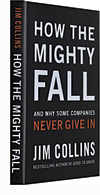Why “Built to Last” Companies Didn’t
A review of How the Mighty Fall and Why Some Companies Never Give In, by Jim Collins.
(originally published by Booz & Company)How the Mighty Fall and Why Some Companies Never Give In
By Jim Collins
HarperCollins, 2009, 240 pages
 There is much to criticize about the business book genre: Many of the books are articles that don’t merit expansion; loose use of metaphor by many of their authors is gratuitous; many seek to explain everything, but predict nothing; and far too often, they are full of unfalsifiable truisms. But it is unusual to be able to level all these criticisms at a single book, especially one by such a deservedly prominent management writer as Jim Collins.
There is much to criticize about the business book genre: Many of the books are articles that don’t merit expansion; loose use of metaphor by many of their authors is gratuitous; many seek to explain everything, but predict nothing; and far too often, they are full of unfalsifiable truisms. But it is unusual to be able to level all these criticisms at a single book, especially one by such a deservedly prominent management writer as Jim Collins.
Collins opens How the Mighty Fall and Why Some Companies Never Give In on a defensive note by apologizing for the shortness of a book that began life as an article and has been expanded to 123 pages, to which a voluminous appendix and footnotes that consist mostly of press clippings have been added.
The defensive tone continues as it becomes apparent that Collins’s purpose is to explore the fall from grace of some of the companies previously held up as paragons of success in his worthy bestsellers, Built to Last: Successful Habits of Visionary Companies (with Jerry I. Poras; Harper Business, 2004) and Good to Great: Why Some Companies Make the Leap...and Others Don’t (Harper Business, 2001). These events do not negate his prior research, he adds, since it was designed to explain why companies become great, not to predict which ones would continue in that state. He does not consider the thought that their subsequent poor performance might represent a natural, statistical regression to the mean.
After a ritual acknowledgment that correlation is not the same as causation, Collins proceeds to raise a “disease” called hubris to the level of a causal principle. According to the author, there are five stages of organizational decline: hubris born of success, undisciplined pursuit of more, denial of risk and peril, grasping for salvation, and capitulation to irrelevance or death. These descriptions are a catchy way of punctuating corporate decline, but although they may be obvious in hindsight, they are murky in prospect. A sustained effort can be accurately characterized as either “persistent” or “obstinate,” for example. It all depends on the outcome of the effort — before that, it’s just a matter of opinion.
Some of the book’s lists, which contrast adaptive with maladaptive behavior, are frankly an insult to the reader’s intelligence. Should you “create momentum with a series of good decisions, supremely well executed, that build one upon another” or “destroy momentum with chronic restructuring and/or a series of inconsistent big decisions”? Umm.... The closing paean to the indomitable spirit of Winston Churchill is embarrassing and worthy only of the self-help community.
Throughout this chronicle of corporate collapse, Collins implies that if only the fallen firms had stuck to the principles articulated in his previous books, they would have remained great. Never mind that Clayton Christensen’s careful research on disruptive innovation suggests that in some circumstances Collins’s “hedgehog concept” of sticking close to one’s customers can be seriously flawed. If a framework explains everything but predicts nothing, then surely it suggests that the future is contingent on much more fine-grained issues than can be captured with coarse-grained principles abstracted from the past. ![]()
Author profile:
- David K. Hurst is a contributing editor of strategy+business. His writing has also appeared in the Harvard Business Review, the Financial Times, and other leading business publications. Hurst is the author of Crisis & Renewal: Meeting the Challenge of Organizational Change (Harvard Business School Press, 2002).

